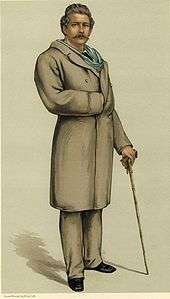Charles Lawes-Wittewronge
Sir Charles Bennet Lawes-Wittewronge, 2nd Baronet (3 October 1843 – 6 October 1911) was an English rower, athlete and sculptor. He exhibited twelve works at the Royal Academy.

Life
Lawes was born at Teignmouth, Devon, the only son of Sir John Lawes of Rothamsted Manor, Hertfordhire. He was educated at Eton and Trinity College, Cambridge.[1] At Cambridge he won the Colquhoun Sculls in 1862 and won the Diamond Challenge Sculls at Henley Royal Regatta in 1863.[2] He excelled in the university distance running events and received an athletics Blue in 1864 for the mile at the Inter University sports, which he won again in 1865. He was a rowing Blue in 1865 when he stroked the losing Cambridge crew in the Boat Race but was in the winning crew of the Ladies' Challenge Plate at Henley. He was beaten by Edward Michell in the Diamond Challenge Sculls in 1865, but won the Wingfield Sculls beating Walter Bradford Woodgate.[3] In 1865 he was the Amateur Athletics Club champion for the mile.
Lawes decided to become a sculptor, and began his training in London under John Henry Foley RA. In 1869 he studied under Hugo Hagen in Berlin. He rented a studio in Chelsea, and in 1872, he exhibited his first work at the Royal Academy, Girl at the Stream. In 1878 he won an honourable mention at the Paris Universal Exhibition. He also exhibited his Daphne at the Royal Academy in 1880 and The Panther in 1881.[4] Lawes also carried out work for the scientific side of the Lawes Agricultural Trust, founded by his father, and became its chairman.
In 1882 Lawes was involved in a libel case after he had imputed in the magazine Vanity Fair and elsewhere that another sculptor, Richard Claude Belt, was dishonest for taking credit for work done by someone else. The long trial, the last to be heard by the High Court of Justice in Westminster Hall, occupied the court for 43 sittings and excited much public interest at the time. The question at issue was how much a sculptor may be aided by others in work to which he attaches his name. Eventually the case was decided against Lawes, and Belt was awarded £5,000 damages.[5]
In 1898, at age fifty-five, Lawes took up cycle racing and held the National Cycling Union amateur record for twenty-five miles, covering it in 51 minutes 15.8 seconds.
Lawes succeeded his father as Baronet on 31 August 1900, and in 1902 he assumed for himself and his heirs by Royal Licence the additional surname (and arms) of Wittewronge.[6] He was one of the founders of the Royal Society of British Sculptors in 1902 and became its second president.
In 1902, Lawes helped judge the world's first major bodybuilding competition. Organized by famed strongman Eugen Sandow, the event was held in London's Royal Albert Hall, and was judged by Lawes, Sandow and Sir Arthur Conan Doyle.[7]
In 1906 Lawes-Wittewronge executed The Death of Dirce, a bronze sculptural group based on the Farnese Bull, a classical work depicting the same subject. This was followed by a colossal marble version, exhibited at the Franco-British Exhibition in 1908, at the same time as the bronze was being exhibited at the Royal Academy. The marble is now in the grounds at Rothamsted. In 1911, after the sculptor's death, a plaster version was exhibited at the International Fine Arts Exhibition in Rome. That same year his widow offered the bronze to the National Gallery of British Art (later the Tate Gallery). Too large to be satisfactorily displayed indoors, it was installed on the terrace to the left of the building's entrance, where it still stands.[8]
Family
Lawes married Marie Amelie Rose on 8 April 1869. Their only child, John, succeeded to the baronetcy on his father's death at Rothamsted at the age of 68, after an operation for appendicitis.
Works
Notes
- "Lawes [post Lawes-Wittewronge], Charles Bennet (LWS862CB)". A Cambridge Alumni Database. University of Cambridge.
- Henley Royal Regatta Results of Final Races 1839-1939 Archived 9 March 2012 at the Wayback Machine
- Wingfield Sculls Record of Races
- Community Archives The RBS Archive Newsletter September 2008 - Issue No. 12
- B. S. Long; rev. Martin Barnes (2004). "Wittewronge, Sir Charles Bennet Lawes-, second baronet (1843–1911)". Oxford Dictionary of National Biography. Oxford University Press.
- "No. 27429". The London Gazette. 29 April 1902. p. 2860.
- "Archived copy". Archived from the original on 25 March 2010. Retrieved 14 September 2009.CS1 maint: archived copy as title (link)
- Ward-Jackson, Philip (2011). Public Sculpture of Historic Westminster: Volume 1. Liverpool University Press. p. 157.
References

- Long, Basil Somerset (1912). . Dictionary of National Biography (2nd supplement). London: Smith, Elder & Co.
- B. S. Long, rev. Martin Barnes. "Wittewronge, Sir Charles Bennet Lawes-, second baronet (1843–1911)". Oxford Dictionary of National Biography (online ed.). Oxford University Press. doi:10.1093/ref:odnb/34430. (Subscription or UK public library membership required.)
| Baronetage of the United Kingdom | ||
|---|---|---|
| Preceded by Sir John Lawes |
Baronet (of Rothamsted) 1900–1911 |
Succeeded by Sir John Lawes-Wittewronge |